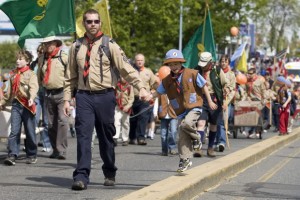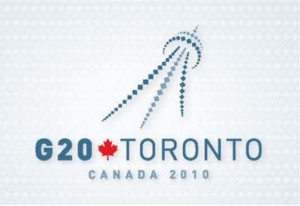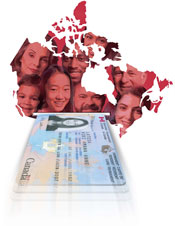What does it mean to be a Torontonian?

What does it actually mean to be a Torontonian?
Recently, the issue of identity has been on my mind lately. When I read through the newspaper and catch the on-line headlines that seem to continuously flash before my eyes, issues and events are defined in certain perspectives; the liberal perspective, the conservative perspective, the global consciousness, national interest, municipal benefits. Each article identifies with a certain group of people, beliefs and ideology.
So when we talk about Toronto and what we want to see our city become, is it really for the collective good or individual? We are an extremely multicultural city and will always be very proud of the number of languages and cultures that fill our city streets.
I feel that we need to think about what actually brings us all together. What connects our city? Leafs nation is still going strong (don’t ask me how or why), but let’s face it, although it’s a big group of people it still doesn’t define our city.
My vision for the future of Toronto is finding our identity and embodying what it means to be a Torontonian. What are our values? We all know what our own values are, but as a community what do we stand for?
Is it too radical to suggest we should have community animators in every part of the city strengthening the bond that holds us all together through local centres, libraries, schools and businesses.
I’m not talking about pricey government supported programs, which I truly believe we need more of, but going back to grass roots; people helping people. Whether this is a “learn to play” night for kids at the local community centre or a book/movie exchange at the library, the importance is consistency.
We must continue to bring people together and I believe and would expect my provincial government and those who govern us to do just that.
Thousands watch Victoria Day parade

Victoria, B.C. – People of all ages packed Douglas Street this morning to enjoy the Island Farms Victoria Day parade.
The American marching bands were a big hit as they are every year, with the high school students playing and dancing for the crowd.
“They’re my favourite,” said 86-year-old Richard Begg, tapping his toes and snapping his fingers. The senior hasn’t missed a parade in the eight years he’s lived at John Alfred Manor on Douglas Street, and has a prize seat every year.
“I just go down the elevator.”
It’s not quite as easy for others, and some avid parade goers plan their strategy to get a premiere spot.Last year, Cynthia Johnson saw people parking their vehicles on side street, backing up to Douglas and opening up the back of their SUVs for a spot to sit. Her family did the same this year, giving Johnson the perfect perch to cheer on the parade.
Johnson clapped and shouted out encouragement to the people in the parade, and soon others around her were doing the same.
“I want to show appreciation for the people who participate and cheering makes it a lot more fun for people,” she said. “If you walk up and down the street, the people having the most fun are the ones cheering.”
The 30-year-old likes the feeling of community parades bring out in people, something that can be lacking in day-to-day life.
“It is a time when people come together.”
Many families had three generations watching the parade together, sitting on deck chairs and snacking on picnics made specially for the occasion.
Some floats were elaborate concoctions, while other entries were as simple as a girl walking with her dog, balloons on the dog’s collar.
It’s a chance for community groups to strut their stuff too.
“I didn’t know the Shriners still existed,” said a woman as the fez-wearing group marched by.
The entrants are judged in several categories, with results expected early this afternoon.
Thousands of people lined downtown Victoria streets today as the city’s largest parade made its way from Mayfair Mall down Douglas Street.
The annual Island Farms Victoria Day Parade featured more than 100 entries including local and American high school bnads, floats, clowns and dancing groups.
Now in its 112th year, the parade draws more than 100,000 viewers live and on television. The parade is being broadcast on CHEK-TV.
The parade features 23 marching bands from the U.S., seven more than last year. There will be 127 parade entries in total, including a delegation from Marioka, Japan.
Take our FREE Online Assessment Today!
Socialize with Abrams & Krochak
Get ready for security checks during G20 summit

Getting home will become a lot more complicated for residents of 33 University Ave.
The 28-storey financial district condominium is the only residential building slated to be stuck inside a fenced security perimeter when the G20 summit touches down in Toronto next month.
The only way in and out will be through police checkpoints.
“It’s definitely an inconvenience,” said Duyen Briggs, who lives at The Empire Plaza at University Ave. and Wellington St. “I guess that week I’ll feel like I’m going to be blocked inside my house for a while.”
As security details for the G20 summit continue to trickle out, downtown residents and businesses are beginning to understand how their lives will be affected.
Empire Plaza residents discovered over the weekend their homes will be enclosed within a security fence expected to go up about two weeks before the summit opens at the Metro Toronto Convention Centre on June 26.
Residents will have to apply for advance security clearance to receive a special ID card to gain express access to their building.
The general public will be allowed to enter the fenced-in area — the borders of which haven’t yet been disclosed — but will be subject to on-the-spot security checks by police and will have to explain why they need to enter the area.
Councillor Adam Vaughan, whose ward will be home to the summit, said anyone living or working behind the fence should preregister with police to receive a swipe card with photo ID to bypass the public line, where the queue for admission could be several hours long.
Todd Reid, an Empire Plaza resident, said he will get the accreditation if it means skipping the long lines.
“If the wait’s only five or 10 minutes, I can deal with that,” he said. “It’s hard to say. We’re pretty much still in the dark.”
The building’s property manager said there are still many unanswered questions, and what he does know, he’s had to piece together from different sources.
“We’ve somewhat been left to fend for ourselves to try to get as much information as we can,” said Wes Posthumus, president of Post Real Property Inc.
“There hasn’t been one decisive document that says, ‘Hey, this is what it’s going to be like, this is what it’s going to look like, this is what you’re going to be subject to during that 10-day or whatever period of time.”
Among the many questions residents have is how — or whether — they’ll be able to access the underground parking garages.
While the Empire Plaza is currently the only residential building behind the fence, security plans can change and more buildings could be affected, Vaughan said.
“We’ve been working very hard to make sure that the residents of our ward have as much freedom during the G20 as possible,” he said.
Police say three security zones will surround the summit:
• A heavily restricted “red zone” will include the convention centre and nearby hotels. Only summit attendees and venue employees will be able to get in.
• The fenced security perimeter, which includes The Empire Plaza and contains 15,000 to 30,000 residents and workers who will be vetted by police at checkpoints.
• A traffic zone will comprise the area from Yonge St. to Spadina Ave. and King St. to Lake Ontario. Pedestrians will be able to come and go, but drivers will be met by officers at most major intersections who will ask them where they’re going and what they’re doing there.
Take our FREE Online Assessment Today!
Socialize with Abrams & Krochak

Take our FREE Online Assessment Today!
Socialize with Abrams & Krochak
Archives
- November 2025
- June 2025
- March 2025
- February 2025
- December 2024
- October 2024
- June 2024
- May 2024
- April 2024
- January 2024
- November 2023
- July 2023
- June 2023
- May 2023
- January 2023
- November 2022
- April 2022
- March 2022
- February 2022
- October 2021
- June 2021
- April 2021
- October 2020
- September 2020
- June 2020
- May 2020
- April 2020
- March 2020
- December 2019
- January 2019
- December 2018
- November 2018
- August 2018
- June 2018
- April 2018
- January 2018
- December 2017
- November 2017
- April 2017
- January 2017
- December 2016
- November 2016
- October 2016
- September 2016
- August 2016
- August 2015
- January 2015
- December 2014
- November 2014
- June 2014
- April 2014
- March 2014
- February 2014
- December 2013
- May 2013
- April 2013
- January 2013
- December 2012
- August 2012
- June 2012
- March 2012
- January 2012
- September 2011
- August 2011
- July 2011
- June 2011
- February 2011
- January 2011
- December 2010
- November 2010
- September 2010
- August 2010
- July 2010
- June 2010
- May 2010
- April 2010
- March 2010
- February 2010
- January 2010
- December 2009
- November 2009
- October 2009
- September 2009
- August 2009
- August 2008
- July 2008
- June 2008
- May 2008
- April 2008
- March 2008
- February 2008
- January 2008
